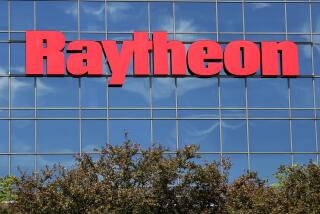Grand Jury Probes TOW Missile Costs at Hughes Aircraft
- Share via
A federal grand jury in Birmingham, Ala., is investigating criminal allegations that Hughes Aircraft, a General Motors subsidiary, fraudulently overcharged the Army on missile contracts, it was learned Friday.
The grand jury has subpoenaed Hughes Executive Vice President D. Kenneth Richardson to testify in the near future and has already subpoenaed 13 other Hughes officials since February, a company spokesman confirmed.
The U.S. attorney’s office in Birmingham has interviewed Malcolm R. Currie, the recently appointed president of Hughes who was once in charge of Hughes Missile Systems Group in Canoga Park.
The grand jury in Birmingham is reportedly studying charges that Hughes improperly collected multimillion-dollar profits on a 1983 TOW missile contract, in which Hughes incurred lower than expected production costs. It could not be learned who originally made the allegations.
The Los Angeles-based aerospace firm denied any wrongdoing.
“After a thorough investigation, our counsel has advised that neither Hughes nor any of its employees committed any wrongful acts in respect to the TOW missile contract awarded in 1983,” a Hughes spokesman said. “The company has substantial legal argument that it complied with the Truth in Negotiation Act.”
The TOW contract was valued at about $120 million and covered production of TOW missiles in 1983 and 1984.
The allegations apparently involve whether Hughes disclosed to the Army that it was planning to transfer the production of missile wiring systems from its missile assembly complex in Tucson to a facility the firm built in Eufaula, Ala., that employs about 400 workers. Hughes opened the facility in October, 1982.
If Hughes successfully lowered its production cost by transferring the work and had anticipated the cost reduction when it negotiated its 1983 contract, the company may have violated the Truth in Negotiation Act.
Typically, a defense contract is negotiated on the basis of the projected cost of producing a weapon. Any reduction in the actual production cost often requires a forfeiture of a portion of the profit, especially if the cost reduction was anticipated before the contract was signed.
Lockheed, for example, has become locked in an acrimonious battle with Pentagon auditors over profits on the production of the C-5B cargo plane after the company successfully negotiated a wage reduction with its labor unions. The Air Force contended that Lockheed should have anticipated that the unions would agree to wage reductions when it negotiated its contract and has demanded that the company forfeit some of its profit.
Hughes Vice President Lee Pitt said the investigation involving Hughes started five years ago, but the case apparently has recently begun to heat up. It is not known when Richardson is scheduled to appear before the grand jury.
In addition to the recent subpoenas issued to Hughes officials, at least seven government employees have appeared before the grand jury.
This is the second federal investigation involving Hughes to be disclosed this month. Another grand jury is investigating whether Hughes consultants in South America diverted some of their fees to a Hughes customer in connection with the sale of satellites.
Amid news of that investigation, Albert Wheelon abruptly retired as chairman. He has since declined to comment on his departure.
Currie, Wheelon’s successor, became head of the missile group in 1977 and left six years later when he was promoted to Hughes executive vice president. In 1986, he became president of Delco Electronics, another GM unit. Richardson followed Currie as head of the missile group and later was promoted to Hughes executive vice president.
Hughes has built more than 400,000 TOWs, an acronym standing for “tube-launched, optically tracked, wire-guided missile.” The missile, which is used by the Army, Marine Corps and more than 30 other nations around the world, is designed to attack tanks and other armored vehicles and is guided to its target by a gunner who visually controls it through a wire that spools out of its rear end.
More to Read
Inside the business of entertainment
The Wide Shot brings you news, analysis and insights on everything from streaming wars to production — and what it all means for the future.
You may occasionally receive promotional content from the Los Angeles Times.







